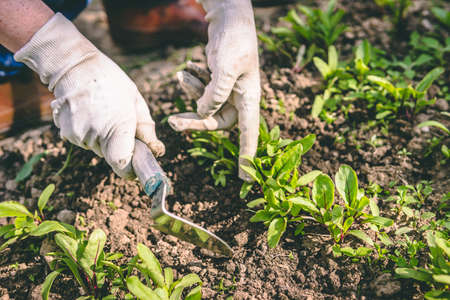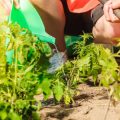Understanding Cool-Season Crops
Cool-season crops are vegetables that grow best in the cooler temperatures of early spring or fall. Unlike warm-season plants that need heat to thrive, cool-season crops prefer mild days and chilly nights. These crops can often tolerate light frosts and even short freezes, making them perfect for planting as soon as the ground can be worked in spring.
What Makes a Crop “Cool-Season”?
The key characteristics of cool-season crops include their ability to germinate and grow in lower soil and air temperatures, their resistance to frost, and their relatively fast growth cycles. Many of these vegetables can be sown directly into the garden weeks before the last expected frost date in your area.
Temperature Tolerance
Cool-season crops generally thrive when daytime temperatures range between 40°F and 75°F. They may bolt or become bitter if exposed to prolonged heat. Some hardy varieties can survive temperatures as low as 20°F with protection.
| Crop | Minimum Soil Temp for Germination | Frost Tolerance |
|---|---|---|
| Spinach | 35°F | High (survives down to 20°F) |
| Lettuce | 40°F | Moderate (light frost tolerant) |
| Peas | 40°F | High (can handle light freezes) |
| Kale | 45°F | Very High (flavor improves after frost) |
Light Requirements
Most cool-season vegetables prefer full sun, which means at least six hours of direct sunlight per day. However, since early spring days are shorter and the sun is less intense, they can also manage in partial shade—especially in warmer zones where too much heat can cause stress.
Why Theyre Ideal for Early Spring Planting
Early spring is the perfect time to plant cool-season crops because the weather supports healthy growth without the risk of overheating. These plants take advantage of moist soil from snowmelt or spring rain and avoid many common pests that arrive later in the season. Plus, getting an early start allows gardeners to harvest sooner and make room for summer crops later on.
2. Timing Your Early Spring Planting
Getting the timing right is key when planting cool-season crops in early spring. These hardy vegetables love chilly weather, but planting too soon—or too late—can impact their growth. To figure out the best time to plant, you’ll want to consider three main factors: your USDA Hardiness Zone, soil temperature, and your areas average last frost date.
Know Your USDA Hardiness Zone
The USDA Hardiness Zone Map divides the U.S. into zones based on average minimum winter temperatures. Knowing your zone helps you understand what types of plants will thrive in your region and when its safe to start planting outdoors.
| Zone | Approximate Last Frost Date |
|---|---|
| Zone 3 | May 15 – May 31 |
| Zone 4 | May 1 – May 15 |
| Zone 5 | April 15 – April 30 |
| Zone 6 | April 1 – April 15 |
| Zone 7 | March 15 – March 31 |
| Zone 8 | March 1 – March 15 |
Check Soil Temperature Before You Plant
Cool-season crops like spinach, peas, lettuce, and broccoli don’t just need cool air—they also need the right soil temperature to sprout. Most of these crops prefer soil temperatures between 40°F and 60°F for germination. Use a soil thermometer to check this a few inches below the surface in the morning before planting.
Ideal Soil Temperatures for Common Cool-Season Crops:
| Crop | Ideal Soil Temp (°F) |
|---|---|
| Lettuce | 40–60°F |
| Spinach | 45–65°F |
| Kale | 45–75°F |
| Peas | 40–70°F |
| Bok Choy | 50–70°F |
Your Last Frost Date Matters
The last frost date is the average date of the final spring freeze in your area. Planting before this date can risk damage from unexpected cold snaps. While many cool-season crops are frost-tolerant, it’s still a good idea to check your local frost forecast or use row covers if you’re planting close to this date.
A Quick Tip:
If youre unsure about your exact last frost date, reach out to your local extension office or check online resources like the National Weather Service or the Old Farmers Almanac.
This timing guide helps ensure your early spring garden gets off to a strong and healthy start by matching your planting with Mother Nature’s schedule.
![]()
3. Top Cool-Season Vegetables to Grow
Spring is the perfect time to get your garden started with cool-season vegetables. These crops love the chillier temperatures of early spring and can handle a light frost, making them ideal for American gardens from coast to coast. Here are some of the most popular and reliable choices:
Spinach
Spinach is a fast-growing leafy green that thrives in cool weather. It can be harvested young for baby greens or allowed to mature for larger leaves. Sow seeds directly into the soil as soon as it’s workable in early spring.
Kale
Kale is not only cold-tolerant but also improves in flavor after a light frost. It comes in different varieties like curly, dinosaur (lacinato), and red Russian. Kale is easy to grow and provides a continuous harvest throughout the season.
Peas
Both shelling peas and snap peas perform well in early spring. They prefer cooler temperatures and will slow down once the weather gets too warm. Use trellises or supports to help pea vines grow upright and make harvesting easier.
Lettuce
Lettuce loves the cool spring air and grows quickly, making it perfect for succession planting every couple of weeks. There are many types to choose from—crisphead, butterhead, romaine, and leaf lettuce all do well in spring gardens.
Broccoli
This nutrient-rich vegetable thrives when planted early in the season. Broccoli prefers steady, cool temperatures and needs consistent watering to form tight heads. It’s best to start broccoli indoors and transplant it once outdoor temperatures are suitable.
Quick Reference Table: Cool-Season Veggies
| Vegetable | Sow Time | Harvest Time | Special Tips |
|---|---|---|---|
| Spinach | Early Spring (direct sow) | 30–45 days | Sow thickly; prefers partial shade as temps rise |
| Kale | Early Spring (direct or transplant) | 50–70 days | Tolerates frost; pick outer leaves first |
| Peas | As soon as soil thaws (direct sow) | 60–70 days | Add support; avoid overhead watering |
| Lettuce | Early Spring (direct sow) | 30–60 days depending on type | Sow successively for continuous harvests |
| Broccoli | Start indoors 6-8 weeks before last frost, then transplant | 60–100 days from seed | Avoid heat stress; keep soil moist but not soggy |
Selecting these cool-season vegetables gives you a strong start to your gardening year, with harvests coming in just weeks after planting. Theyre dependable favorites that bring fresh flavors to your kitchen while making the most of early springs growing conditions.
4. Preparing Your Garden for Spring Success
To get the most out of your cool-season crops like spinach, lettuce, kale, peas, and radishes, its important to start with a strong foundation. That means preparing your garden properly before planting. Here’s how you can set up your garden beds to give early spring vegetables their best shot at thriving.
Soil Preparation Tips
Healthy soil is key to growing strong plants. Start by checking the texture of your soil. It should be crumbly and not too compacted. If it feels heavy or clay-like, mix in some organic matter to improve drainage and structure.
Steps for Prepping Soil:
- Test your soil: Use a home test kit to check pH and nutrient levels.
- Add compost: Mix in 2–3 inches of compost to enrich the soil with nutrients.
- Till or loosen: Loosen the top 6–8 inches of soil using a garden fork or tiller.
- Avoid wet soil: Wait until the soil is dry enough so it doesn’t clump when squeezed.
The Power of Composting
Compost is a gardener’s best friend. It improves soil texture, adds nutrients, and boosts beneficial microbial life that helps your crops grow strong from the start.
What You Can Compost:
| Green Materials | Brown Materials |
|---|---|
| Fruit and veggie scraps | Dried leaves |
| Coffee grounds | Shredded paper |
| Grass clippings | Sawdust (untreated) |
A good compost pile should have a balance of green (nitrogen-rich) and brown (carbon-rich) materials. Turn your compost regularly and keep it moist, like a wrung-out sponge.
The Benefits of Raised Beds
If youre gardening in an area with poor drainage or compacted soil, raised beds can make a big difference—especially for early spring planting when soils are still cold and wet.
- Better drainage: Raised beds warm up faster in spring and allow excess water to drain away easily.
- Easier access: Less bending over makes planting and weeding easier on your back.
- Pest control: Raised beds help deter weeds and some pests better than traditional ground plots.
You can build raised beds from untreated wood, metal, or even recycled materials. Aim for beds that are no wider than 4 feet so you can reach the center without stepping into them.
Recommended Raised Bed Dimensions:
| Length | Width | Height |
|---|---|---|
| 6–8 feet | No more than 4 feet | 10–12 inches |
A well-prepared garden bed sets the stage for healthy cool-season vegetables to thrive—even when spring weather is unpredictable. With just a bit of effort now, you’ll enjoy fresh greens and crisp veggies before summer even arrives!
5. Tips for Frost Protection and Weather Challenges
Early spring can be unpredictable—one day its sunny and mild, the next youre facing a surprise frost. If youre growing cool-season crops like lettuce, spinach, peas, or broccoli, protecting them from these temperature swings is key to keeping your garden thriving. Luckily, there are simple tools and techniques you can use to shield your plants from cold snaps and extend your growing season.
Use Row Covers for Quick Protection
Row covers are lightweight fabrics that you drape directly over your crops. They allow sunlight, air, and moisture to pass through while offering insulation against chilly nights. Floating row covers are especially handy because they don’t need a frame—just anchor them with soil or garden staples along the edges.
Benefits of Row Covers:
- Protects from light frost (typically down to 28°F)
- Helps retain warmth during the day
- Can also keep out pests like aphids and cabbage worms
Cold Frames: Mini Greenhouses for Your Garden
A cold frame is a bottomless box with a clear lid that traps heat from the sun, creating a warmer microclimate for your plants. Theyre great for hardening off seedlings or giving an early start to crops like kale or radishes.
How to Use a Cold Frame:
- Place it in a sunny spot facing south if possible
- Open the lid during warm days to prevent overheating
- Close it at night to retain heat
Additional Season Extension Tools
If you want more flexibility or are gardening in regions with frequent cold snaps, consider other protection options too. Heres a quick comparison:
| Tool | Best For | Protection Level |
|---|---|---|
| Row Covers | Lettuce, carrots, spinach | Light frost (28-32°F) |
| Cold Frames | Kale, beets, herbs | Moderate frost (down to 26°F) |
| Cloches (mini domes) | Individual young plants | Light to moderate frost |
| Low Tunnels (with plastic) | Larger beds of greens or root veggies | Heavy frost (below 26°F) |
Watch the Forecast and Be Prepared
The best way to avoid crop damage is by staying ahead of the weather. Keep an eye on local forecasts in early spring and cover your plants before temperatures dip below freezing. With the right setup, your cool-season crops will stay safe and productive even when nature throws you a curveball.
6. Harvesting Cool-Season Crops for Peak Flavor
Timing is everything when it comes to harvesting cool-season crops in early spring. Picking vegetables at the right moment ensures the best flavor, texture, and nutritional value. It also helps your garden stay productive longer by encouraging new growth for repeat harvests.
How to Tell When Your Cool-Season Crops Are Ready
Each vegetable has its own signs that its ready to harvest. Here’s a quick guide to help you know when to pick some common cool-season crops:
| Vegetable | When to Harvest | What to Look For |
|---|---|---|
| Lettuce | 30–60 days after planting | Leaves are full-sized but still tender; avoid waiting until they bolt (flower) |
| Spinach | 35–45 days after planting | Leaves are dark green and about 4–6 inches long |
| Radishes | 20–30 days after planting | The root is about 1 inch in diameter and visible above the soil line |
| Peas (snap or snow) | 60–70 days after planting | Pods are plump but not bulging; snap easily when bent |
| Kale | 55–75 days after planting | Younger leaves (baby kale) are tender and perfect for salads; mature leaves are best for cooking |
| Bok Choy | 45–60 days after planting | The base is firm, and leaves are full-sized but not yellowing or bolting |
Tips for Harvesting to Encourage Continued Growth
Certain cool-season crops can be harvested multiple times if done correctly. This method, known as “cut and come again,” works well with leafy greens like lettuce, spinach, and kale.
- Lettuce & Spinach: Use scissors or garden shears to snip outer leaves about an inch above the base. Leave the center intact so new growth can continue.
- Kale: Pick lower leaves first, leaving at least 4–5 inner leaves on the plant.
- Bok Choy: You can harvest individual outer stalks or cut the whole plant an inch above the soil to allow regrowth.
- Peas & Radishes: These are typically one-time harvests, but succession planting every few weeks can give you a continuous supply.
Harvesting Tools and Best Practices
A few basic tools can make your harvesting easier and gentler on your plants:
- Garden Scissors or Pruners: Ideal for cutting leafy greens without damaging stems.
- Baskets or Buckets: Use breathable containers to keep freshly picked veggies from wilting quickly.
- Mornings Are Best: Harvest during the cooler part of the day—usually early morning—when plants are crisp and full of moisture.
- Avoid Wet Leaves: Try not to harvest when leaves are wet from dew or rain to reduce disease spread.
Storing Your Harvest for Freshness
If you’re not eating your vegetables right away, proper storage is key. Most leafy greens do best in a plastic bag or sealed container in the fridge with a paper towel inside to absorb moisture. Root veggies like radishes can be stored in a crisper drawer after removing their tops.
With just a little attention to timing and technique, you can enjoy flavorful, homegrown cool-season vegetables all spring long—and even into early summer with repeat harvests!


